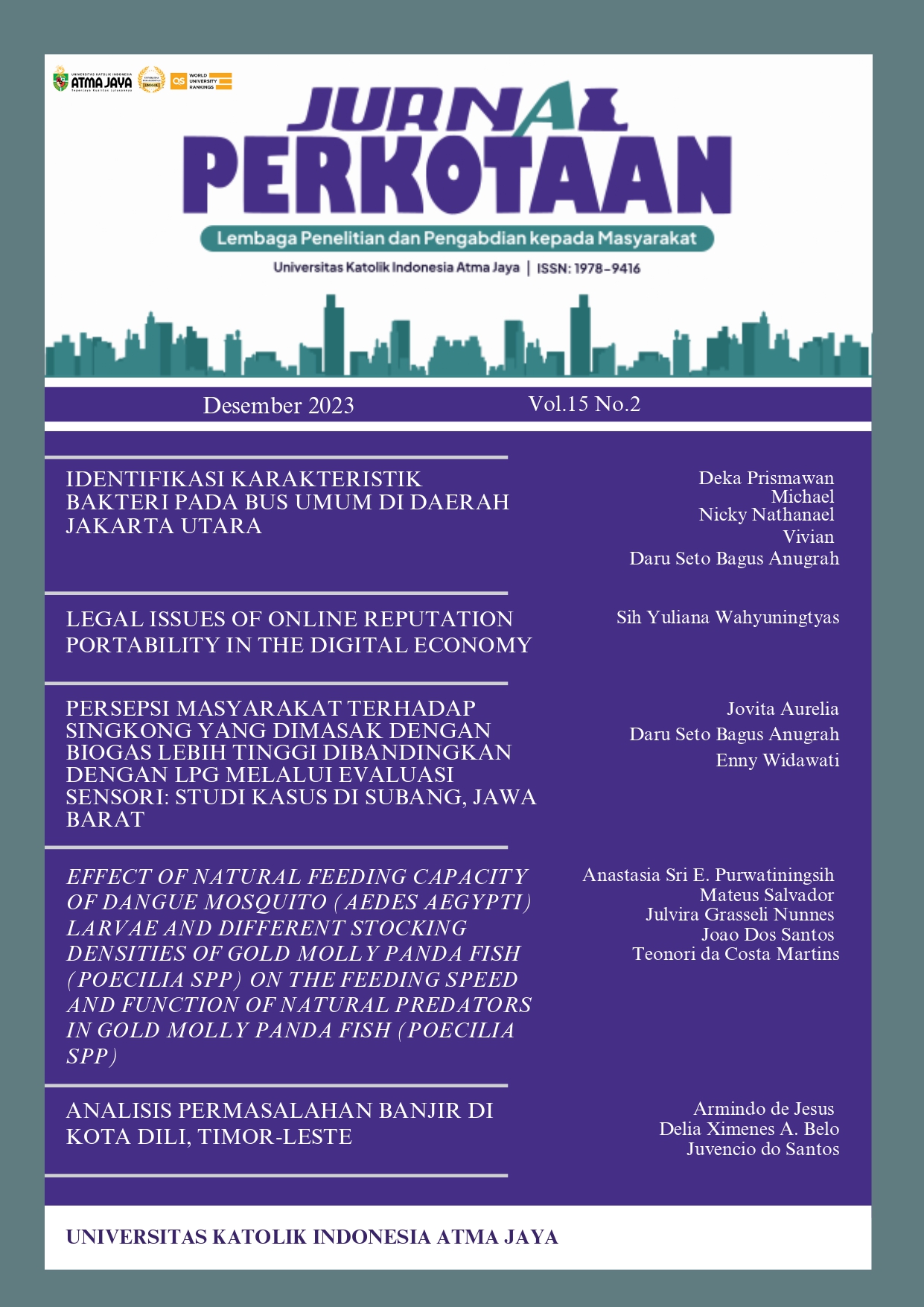Effect of Natural Feeding Capacity of Dengue Mosquito (Aedes aegypti) Larvae and Different Stocking Densities of Gold Molly Panda Fish (Poecilia spp) on the Feeding Speed and Function of Natural Predators in Gold Molly Panda Fish (Poecilia spp)
DOI:
https://doi.org/10.25170/perkotaan.v15i2.5600Keywords:
Speed of consumption, Natural food, Dengue mosquito (Aedes aegypti) larvae, Stocking density, Gold Molly Panda fish (Poecilia Spp)Abstract
The Gold Molly Panda (Poecilia Spp) freshwater ornamental fish is a type of fish that is easy to care for, and bred with high tolerance for the water and environment, lots of diversity, and has good economic value in the ornamental fish market. This interdisciplinary research was aimed at observing the consumption rate and number of natural feedings of dengue mosquito (Aedes aegypti) larvae by Gold Molly Panda (Poecilia Spp) fish with different stocking densities in quantitative apprach in ANOVA two factors whit 10 times replication design using 3 differences in the density of fish stocking groups Gold Panda Molly fish (Poecilia Spp) fish as natural predator and another side to combated or eradication of dengue mosquito (Aedes aegypti) in larvae stages. The scholar has proven that the factors number of feeding and has a very significant effect on the speed of consumption of Gold Molly Panda (Poecilia Spp) fish. The results of the comparison analysis have provided recommendations for application that the stocking density of Gold Molly Panda (Poecilia Spp) fish 2 – 4 tails can be eaten between 25 – 75 larvae of the dengue mosquito (Aedes aegypti) in an average time of 133 - 186.67 minutes.
References
H. N. Pedro, C. Clarence, C. Erick, and P. Felipe, "Identification of the Mexican Molly (Poecilia mexicana) Cyprinodontiformes : Poeciliidae ), introduced in Brazil through α -taxonomy and DNA barcoding," Int. J. Ichthyol., vol. 3, no. December, pp. 1-11, 2019. [Online]. : https://doi.org/10.26028/cybium/2019-434-003
V. Sumithra, A. Janakiraman, and K. Altaff, "Influence of Different Type of Feeds on Growth Performance in Black Molly, Poecilia sphenops," Int. J. Fish. Aquat. Stud., vol. 1, no. 6, pp. 24-26, 2014.
Hasnidar and A. Tamsil, "Karakteristik Kimiawi Tepung Ikan Molly, Poecilia Latipinna Hasnidar dan Andi Tamsil," JPHPI, vol. 23, no. 2, pp. 392-401, 2020.
A. Tamsil and Hasnidar, "Aspek Biologi Reproduksi Ikan Molly (Poecilia Latipinna, Lesueur 1821) di Tambak Bosowa Kabupaten Maros," Jurnal Iktiologi Indonesia, vol. 19, no. 3, pp. 375-390, 2019.
A. Tamsil and H. Hasnidar, "Reproductive biology of sailfin molly, Poecilia latipinna (Lesueur, 1821) in tambak Bosowa Kabupaten Maros," J. Iktiol. Indones., vol. 19, no. 3, p. 375, 2019. https://doi.org/10.32491/jii.v19i3.503
T. H. P. Sembiring, "Perbandingan Efektivitas Ikan Black Molly (Poecilia sphenops), Cupang Serit (Betta splendens), dan Cethul (Poecilia reticulata) Sebagai Pengendali Larva Nyamuk Aedes aegypti," Universitas Kristen Duta Wacana, 2011.
B. A. Sandkam et al., "Hybridization leads to sensory repertoire expansion in a gynogenetic fish, the Amazon molly (Poecilia formosa): A test of the hybrid-sensory expansion hypothesis," Evolution, vol. 67, no. 1, pp. 120-130, 2013. https://doi.org/10.1111/j.1558-5646.2012.01779.x
M. Shanmughavalli, K. Narmathanathiya, C. Arulvasu, and D. Chandhirasekar, "Genetic variation between molly fishes Poecilia latipinna and Poecilia sphenops using RAPD assay," J. Acad. Ind. Res., vol. 2, no. 2, pp. 83-88, 2013.
C. Fischer and I. Schlupp, "Feeding rates in the sailfin molly Poecilia latipinna and its coexisting sexual parasite, the gynogenetic Amazon molly Poecilia formosa," J. Fish Biol., vol. 77, pp. 285-291, 2010. https://doi.org/10.1111/j.1095-8649.2010.02672.x
K. V. Meni, F. Rebhung, and F. C. Liufeto, "Pengaruh ekstrak labu kuning (Cucurbita moschata Duch) dalam pakan terhadap kecerahan warna dan kelangsungan hidup ikan badut (Amphiprion percula) di akuarium," J. Aquatik Fak. Kelaut. Dan Perikanan, Univ. Nusa Cendana, vol. 5, no. 2, pp. 144-150, 2022.
R. Zaenuri, B. Suharto, and A. T. S. Haji, "Kualitas pakan ikan berbentuk pelet dari limbah pertanian," J. Sumberdaya Alam & Lingkungan, vol. 1, pp. 31–36, 2017.
A. Septimesy, D. Jubaedah, and A. D. Sasanti, "Pertumbuhan dan kelangsungan hidup ikan patin (Pangasius sp.) di sistem resirkulasi dengan padat tebar berbeda," J. Akuakultur Rawa Indonesia, vol. 4, no. 1, pp. 152–158, 2016.
D. Darwis, J. D. Mudeng, and S. N. J. Londong, "Budidaya ikan mas (Cyprinus carpio) sistem akuaponik dengan padat penebaran berbeda," E-J. Budidaya Perairan, vol. 7, no. 2, pp. 15–21, 2019. https://doi.org/10.35800/bdp.7.2.2019.24148
D. Arianto, H. Harris, I. Anggraini Yusanti, and A. Arumwati, "Padat penebaran berbeda terhadap kelangsungan hidup, FCR dan pertumbuhan ikan bawal air tawar (Colossoma macropomum) pada pemeliharaan di waring," J. Ilmu-Ilmu Perikanan Dan Budidaya Perairan, vol. 14, no. 2, pp. 14–20, 2019. https://doi.org/10.31851/jipbp.v14i2.3486
D. Ariyanto, E. Tahapari, and B. Gunadi, "Optimasi padat penebaran larva ikan patin siam (Pangasius hypophthalmus) pada pemeliharaan sistem intensif," J. Perikanan Universitas Gadjah Mada, vol. 10, no. 2, pp. 158–166, 2012.
H. B. Nugroho, F. Basuki, and R. Wisnu, "Pengaruh padat penebaran yang berbeda terhadap laju pertumbuhan ikan nila (Oreochromis niloticus, Linn. 1758) pada sistem budidaya minapadi," J. Aquaculture Management and Technology, vol. 6, no. 2, pp. 21–30, 2017.
M. Melanie, M. M. Rustama, I. S. Sihotang, and H. Kasmara, "Effectiveness of storage time formulation of Bacillus thuringiensis against Aedes aegypti larvae (Linnaeus, 1757)," Cropsaver, vol. 1, no. 1, pp. 48–52, 2018. https://doi.org/10.24198/cs.v1i1.16999
I. Agustin, U. Tarwotjo, and R. Rahadian, "Perilaku bertelur dan siklus hidup Aedes aegypti pada berbagai media air," J. Biologi, vol. 6, no. 4, pp. 71–81, 2017.
N. Agustina, A. Abdullah, and E. Arianto, "Hubungan kondisi lingkungan dengan keberadaan jentik Aedes aegypti di daerah endemis DBD di Kota Banjarbaru," Fakultas Kesehatan Masyarakat Universitas Islam Kalimantan Muhammad Arsyad Al-Banjary Banjarmasin, pp. 171–178, 2019. https://doi.org/10.22435/blb.v15i2.1592
N. F. Fauziah, "Karakteristik sumur gali dan keberadaan jentik nyamuk Aedes aegypti," J. Kesehatan Masyarakat UNNES, vol. 8, no. 1, pp. 81–87, 2012.
A. Tomia, U. K. Hadi, S. Soviana, and E. B. Retnani, "Maya Index dan kepadatan larva Aedes aegypti di Kota Ternate, Maluku Utara," Parasitol. Dan Entomol. Kesehat., Fak. Kedokt. Hewan – Inst. Pertanian Bogor, pp. 133–142, 2019. https://doi.org/10.22435/blb.v15i2.1936
E. Yulianti, Juherah, and Abdurrivai, "Perilaku bertelur dan siklus hidup nyamuk Aedes aegypti pada berbagai media air (studi literatur)," Media Komunikasi Sivitas Akademika Dan Masyarakat Sulawesi Selatan, vol. 8, no. 75, pp. 147–154, 2020.
N. L. Achee et al., "A critical assessment of vector control for dengue prevention," PLoS Neglected Tropical Diseases, vol. 9, no. 5, pp. 1–19, 2015. https://doi.org/10.1371/journal.pntd.0003655
World Health Organization (WHO), "Global strategy for dengue prevention and control 2012 - 2020," 2012.
S. Zen, "Biokontrol jentik nyamuk Aedes aegypti dengan predator ikan pemakan jentik sebagai pendukung materi ajar insekta," Bioedukasi (J. Pendidik. Biologi), vol. 3, no. 1, 2012. https://doi.org/10.24127/bioedukasi.v3i1.206
H. Ahmad and N. Nurbaeti, "Analisis kemampuan ikan hias maanvis (Pterophylium altum) dan ikan hias cuppang (Bettasplandens crow tail) sebagai predator jentik nyamuk," Media Komunikasi Sivitas Akademika dan Masyarakat Sulawesi Selatan, vol. 06, no. 1, pp. 68–72, 2018.
M. Susilawati, "Perancangan percobaan," Jurusan Matematika Fakultas Matematika dan Ilmu Pengetahuan Alam Universitas Udayana, 2015, p. 141.
F. Poeser, "From the Amazon river to the Amazon molly and back again," 2022.
T. W. P. Pamulu and Y. Koniyo, "Pemberian cacing sutera untuk pertumbuhan dan kelangsungan hidup benih ikan black molly”, Jurnal Ilmiah Perikanan dan Kelautan, vol. 5, no. 4, pp. 98–106, 2017.










